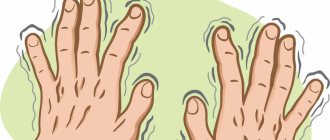What is VSD
Vegetovascular dystonia (VSD), or neurocirculatory syndrome, is a functional disorder of the autonomic nervous system, in which a complex of symptoms appears that are not characteristic of a specific disease. Examination of patients with suspected VSD most often does not reveal changes in the structure of internal organs, but may show deviations in their function at the border of normal.
Autonomic dysfunction cannot be called a full-fledged disease; this diagnosis is not included in the International Classification of Diseases (ICD-10). But therapists, cardiologists and neurologists continue to make this diagnosis to patients in whom the examination did not reveal any disorders, and complaints of poor health continue.
It is believed that manifestations of pathology arise due to disturbances in the coordination of the two structures of the autonomic nervous system. It consists of the sympathetic and parasympathetic systems, which differ in their effects on the body. The activator of sympathy is the hormone adrenaline, so it performs the following functions:
- increases the number of heart contractions;
- increases blood pressure;
- stimulates the release of glucose into the blood;
- dilates the arteries of the brain, lungs and heart;
- reduces saliva secretion;
- suppresses peristalsis of the digestive tract;
- dilates the bronchi and enhances gas exchange;
- enlarges pupils;
- causes spasm of the sphincters of the bladder and digestive tract.
These reactions are necessary to protect the body in a dangerous situation, to activate it to escape. The parasympathetic nervous system works in the opposite direction. It reduces blood pressure, accelerates peristalsis of the intestines and urinary organs, and constricts the pupils and bronchi. The parasympathetic activator is the substance acetylcholine. It slows down the heartbeat, reduces blood glucose levels and relaxes all the sphincters in the body.
Autonomic dystonia occurs when the sympathetic or parasympathetic system is activated spontaneously, for no apparent reason. Therefore, a person suddenly has an increased heartbeat while at rest, his blood pressure rises, and he is worried about anxiety.
But often vegetative-vascular dystonia is a precursor to serious diseases. Having arisen at a young age without treatment, after a few years it leads to the formation of arterial hypertension, heart disease, digestive tract and hormonal disorders.
Article:
He can't sit still for a minute
An easily excited, restless, unbalanced child... For several years, problems with such children have been the subject of surveys and passionate discussions.
As a result, nowadays a tendency has developed (in our opinion, somewhat hasty) to consider such behavior pathological, although mild excitability does not always indicate an existing pathology. Of course, there are behavior problems that occur with a certain frequency, are repeated, and they do require contact with a specialist, but only when the instability is significant, uncontrollable, accompanied by aggression and lasts for a long time.
Most often, we are talking about a response to events around us: maybe the child reacts in a similar way to some problems in the family? And sometimes this is how hidden depression manifests itself: in children it is often expressed precisely in increased mobility - the baby needs movement in order to fight the sadness inside.
Excessive mobility coupled with slight excitability can also simply be a character trait: some children are more restless than others.
What aspects need to be taken into account?
If a child seems to you to be overly active, at some moments he demonstrates this especially clearly - for example, in the yard where a group is walking - but this does not affect anything, including the learning process, you don’t have to worry too much.
Children who manage to control themselves during activities may be more restless and agitated at home.
– A very small child needs to move. Remember, when addressing your baby, that the episodes when you demand attention from him should be short - their duration always depends on the baby’s age.
– When working with your child, alternate the types of his activity : after a period of physical activity, when the child, having moved well, uses up energy, there should be a more “quiet” period, allowing the baby to concentrate.
– Be attentive to the quality of your child’s sleep : no tired child can sit still, fatigue leads to mild excitability.
– Isn’t your baby’s excessive mobility a reflection of life in the family? If this is the case, think about ways to make the family atmosphere more relaxed. Of course, this is not easy, because the child himself provokes stress in adults with his behavior, however, this is where one of the main problems of excitability and mental instability lies: they intensify due to the reaction that they cause in others - therefore, here it is possible talk about something like a self-exciting system.
You feel as if the child is “angry” on purpose - so that you attack him
Yes, “freaking out” is one of the ways for a child to attract your attention when it seems to him that you are moving away and becoming less available to him.
– The main thing in such cases is not to punish! First of all, you need to try to figure out what caused this child’s behavior.
– Think about what in your parenting method can be softened or changed, diversified.
- Find time for your child, try to decipher what signals he is sending you, formulate his requests clearly, unambiguously, calmly and - showing that you are aware of their significance.
– Offer your child calm activities, choosing those that are interesting to him. Child psychiatrist Stanley Greenspan* called this type of activity with children “floor time,” because no one - neither parents nor teachers - hesitates to sit next to the baby on the ground and do something important for him there.
– Arrange “dates” with your child, not necessarily very long ones, but ones when you are actually completely at his disposal. Such a response to the uncontrollability of a son or daughter will help them bring overexcitation, which was solely intended to attract the attention of the mother, into the mainstream of a normal need for you.
However, all this is not always enough to help an overly excitable child.
– The child really suffers - just like you , even if it seems to you that this is not so, even if it seems as if he is responsible for everything. In fact, most often he is a prisoner of his own behavior.
- It is useless, even harmful, to multiply punishments : in the end the baby will hate you or begin to avoid you, afraid to be alone with you. You need to consult a specialist and they will help you.
– In any case, the consultation will be a stage that will allow you to get out of the vicious circle in which you and your child find yourself.
* Stanley Greenspan (1941-2010) - an outstanding child psychiatrist, one of the world's leading specialists in the correction of childhood emotional disorders. His book “The Tyrant Child. An approach to children of five “difficult” types.”
Causes and symptoms of VSD
Adolescents and women are at risk for developing vegetative-vascular dystonia. In men, VSD rarely occurs as an independent syndrome; dystonia is usually associated with other diseases. The causes of the pathology are most often unknown, but its appearance is associated with the following provoking factors:
- stress – constant nervous tension causes the release of stress hormones, which stimulate the autonomic nervous system;
- hormonal changes - physiologically in women during the menstrual cycle, with the onset of pregnancy, menopause, the concentration of sex steroids changes, which indirectly affect the functioning of the nervous system;
- maturation of the nervous system – in adolescents leads to pronounced signs of VSD;
- bad habits - smoking, drinking alcohol, caffeinated drinks cause disturbances in the functioning of blood vessels and the conduction of nerve impulses.
The first symptoms of vegetative dystonia may appear in childhood. They are associated with heredity and characteristics of pregnancy. If the expectant mother suffers from vegetative-vascular dystonia, smokes, and has been diagnosed with arterial hypertension, then the risk of pathology in the child increases significantly. The health of the baby is negatively affected by intrauterine hypoxia, disruption of feto-placental blood flow, as well as the stress experienced by the pregnant woman. Acute fetal hypoxia during childbirth can also lead to the formation of VSD at an early age.
The formation of vegetative-vascular dystonia in adults can be associated with osteochondrosis, head injuries, and poor nutrition. Prolonged life in poor environmental conditions and work in hazardous industries also leads to VSD. Weather-dependent people also often experience dystonia.
Symptoms of autonomic dysfunction are varied; doctors identify more than 40 signs of the disease, but not all of them occur in one patient. Usually this is a combination of 4-5 constant symptoms and several additional ones. Depending on the manifestations of the cardiovascular system, there are three types of vegetative-vascular dystonia:
- cardiac - not accompanied by pressure surges, it is characterized by pain in the heart area or interruptions in its work;
- hypertensive type - a person suffers from high blood pressure, which is accompanied by panic attacks, chills, and increased physical activity;
- hypotensive type – characterized by low blood pressure, which is maintained at 100/50-90/45 mm Hg. Additional concerns include weakness, drowsiness, and dizziness.
Signs of dystonia include periodic shortness of breath, a feeling of shortness of breath, or a sensation of spasm in the throat. Many people complain to the doctor about pain in the heart, a feeling of increased heartbeat, pressure in the chest, interruptions in the heart, but it is rarely possible to record them using an ECG. Symptoms of autonomic dysfunction include decreased appetite, heartburn, flatulence and other digestive disorders. The disease manifests itself in the form of frequent urination or urinary retention, chills and cold extremities, and increased sweating. Many people complain of weather sensitivity, sleep disturbances, mood swings and irritability. In women with VSD, the menstrual cycle may be disrupted or symptoms of premenstrual syndrome may appear 1-2 weeks before menstruation.
The severity of signs of vegetative-vascular dystonia may vary. Depending on the frequency of symptoms, the following types of disease are distinguished:
- paroxysmal – attacks of vegetative-vascular dystonia periodically appear;
- permanent - the symptoms of dystonia are constant, usually mild, but can intensify under the influence of provoking factors;
- mixed - includes characteristics of the two previous types;
- latent type - signs of the disease appear only after severe stress, the rest of the time the symptoms do not bother.
Vegetative-vascular dystonia, if prolonged without treatment, can lead to disturbances in the functioning of the heart. People who are overweight, eat poorly, and suffer from physical inactivity have an increased risk of developing coronary heart disease and hypertension. In women aged 45-50 years, VSD aggravates the course of menopause.
First aid for nervousness and overexcitement
Magazine "Remedium" No. 1-3, 2021
DOI:
10.21518/1561-5936-2020-1-2-3-38-39
Irina Shirokova
,
Yulia Prozherina
, Ph.D.,
“Remedium”
Anxiety, feelings of internal tension, irritability are some of the most common complaints among patients [1]. Along with psychological help, drug therapy is recommended to eliminate stress reactions in everyday life [2]. Valocordin remains one of the most popular drugs among patients to help cope with stress and eliminate its vegetative manifestations.
Pain kept at bay by skilled practitioners
Irina Shirokova
,
Julia Prozherina
, Cand.
of Sci. (Bio.), Remedium
Anxiety, sense of distress, irritability is some of the most common complaints among patients [1]. Along with psychological aid, the prescription of pharmacological therapy is recommended to overcome stress reactions in daily life [2]. Valocordin remains one of the most popular drugs in patients, which helps handle stress and eliminate its vegetative manifestations.
Anxiety disorders are widespread among the population, especially among residents of megacities who live in a stressful environment. Throughout life, individual symptoms of anxiety or various anxiety disorders are detected in approximately 50% of people. Clinically significant anxiety occurs in 5–7% of people in the general population and in more than 25% of patients seen by general practitioners [1].
Scientists from the University of Cambridge, analyzing 48 scientific reviews from 1990 to 2010, concluded that the overall number of people with anxiety disorders has consistently been around 4 in every 100 people. Almost one in ten (10.9%) adults with heart disease had generalized anxiety disorder (GAD). Moreover, GAD occurred twice as often in women as in men. In addition, women with heart disease, cancer, and pregnant women were more anxious than men.
Every hundredth of the general population was diagnosed with obsessive-compulsive disorder (OCD), associated with the emergence of obsessions and aspirations. It turned out that OCD is twice as common in pregnant women. Another interesting fact was that younger men and women (under 35) suffered disproportionately from anxiety compared to the older age group. The study also showed that residents of Western Europe and North America had higher levels of anxiety than other peoples [2].
A feature of anxiety disorders is their multisystem nature. In other words, they are manifested by a whole complex of symptoms, among which are mental, somatic and vegetative. Mental manifestations of anxiety disorders most often include all sorts of fears (fear of failure, feeling of excitement, etc.). Such people are also characterized by worry over little things, a feeling of tension, stiffness, fussiness, inability to relax, inability to concentrate, fatigue, fears, obsessive thoughts, etc. Among the autonomic (somatic) manifestations of anxiety are sweating, cold and wet palms, dry mouth, a feeling of a “lump” in the throat, a feeling of lack of air, tension and pain in the muscles, as well as nausea, diarrhea, abdominal pain, dizziness, decreased libido, etc. [1].
Chronic anxiety disorders require special pharmacotherapy, taking into account the severity of the condition and diagnosis. At the same time, to correct reactions to ordinary stressful events, accompanied by a decrease in adaptive capabilities, sedatives are most often used. These include the drug Valocordin, which has been on the Russian market for more than 20 years and is one of the leaders in terms of sales among products in its category1.
Despite its long history of use, it not only does not lose its relevance, but also maintains stable demand. Thus, at the end of 2021, over 4 million packages of this drug were sold in our country. At the same time, what is especially important, Valocordin maintains positive sales dynamics in physical terms ( Fig.
).
Drawing. Sales dynamics of the drug Valocordin in Russia, million packs.
The wide popularity of Valocordin is associated with its complex effect, which is achieved thanks to the combined composition. The composition of the drug Valocordin includes phenobarbital (18.4 mg/ml), ethyl bromizovalerianate (18.4 mg/ml), as well as mint and hop oil. Phenobarbital is used to relieve nervous tension. Provided the correct dosage is used, the drops provide a mild hypnotic effect, promote rapid falling asleep and restful sleep. Ethylbromoisovalerate regulates the state of the central nervous system, helps a person overcome attacks of panic, anxiety, fear, and helps relieve excessive emotional excitability. In general, the effect of the drug is aimed at states of arousal, accompanied by pronounced vegetative reactions and mild sleep disturbances.2 In general, the effect of the drug is aimed at various manifestations of stress, anxiety states, autonomic dysfunction, mild sleep disturbances, increased excitability and irritability [1, 3].
Valocordin is available in 20 ml bottles. Usually the drug is used 15–20 drops 3 times a day2. When used correctly and following the instructions, the drug is usually well tolerated even with long-term use. The concentration of phenobarbital is minimal, and the bottle with a tight dropper allows you to correctly follow the dosage, even when in a nervous state. The drug should not be used while driving a vehicle. Only if you deviate from the instructions, exceed the duration of use and dosage, addiction can occur, incl. with the formation of a syndrome of dependence on sedatives [3]. Cardiologists and neurologists have long used Valocordin in the practice of symptomatic treatment of autonomic dysfunction in stressful situations. The use of this drug as part of complex therapy can be effective for autonomic disorders associated with acute and chronic stress [3].
1 According to IQVIA, Valocordin is among the top 5 drugs in the EphMRA group “N05B - Hypnotics and sedatives” in value terms at the end of 2021. 2 Instructions for use for the drug Valocordin.
List of literature / References
- Shavlovskaya O.A. Therapy for anxiety. Medical advice. 2019;(6):42–46. doi: 10.21518/2079-701X-2019-6-42-46.
- Discovery: Women and youth are more prone to anxiety disorders. Access mode: https://www.meddaily.ru/article/07Jun2016/jenmol_tr. Access date: 02/18/2020.
- Kutashov V.A. Modern approach to the treatment of autonomic disorders in patients under stressful conditions. Medical advice. 2018;(18):92–95. doi: 10.21518/2079-701X-2018-18-92-95.
Diagnostic methods
Vegetative-vascular dystonia is an exception diagnosis. This means that it is placed after a complete examination of the cardiovascular and nervous systems, if no abnormalities are found in them.
For diagnosis, you need to contact a general practitioner, who, if necessary, will refer you to a cardiologist, neurologist or endocrinologist. In order for a doctor to make an accurate diagnosis, it is necessary to accurately describe the symptoms and the time of their onset. The therapist will definitely clarify whether the patient drinks alcohol, nicotine, how often he drinks coffee and what daily routine he follows. This data is necessary to correctly make recommendations for the treatment of the disease.
To diagnose vegetative-vascular dystonia, the following methods are used:
- laboratory diagnostics - general blood and urine analysis without specific changes, in biochemical analysis the lipid ratio may be disturbed;
- blood test for hormones - a study of thyroid hormones is indicative; if they increase, tachycardia and weight loss may be observed;
- ECG - changes are not typical for VSD, sometimes it is possible to record tachycardia, single extrasystoles, but there are no signs of severe conduction disturbances in the heart;
- EEG - electroencephalogram can reveal slight deviations in the conduction of impulses in the brain;
- Ultrasound of internal organs - examination of the abdominal cavity in case of complaints of indigestion, examination of the heart, kidneys, and pelvic organs in women.
Dysfunction of the nervous system is not accompanied by damage to internal organs; most indicators are within the normal range, despite complaints of poor health.











